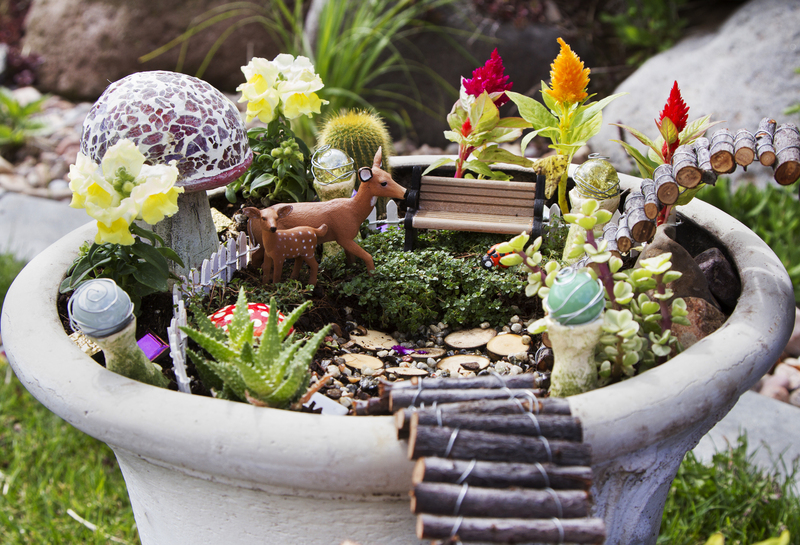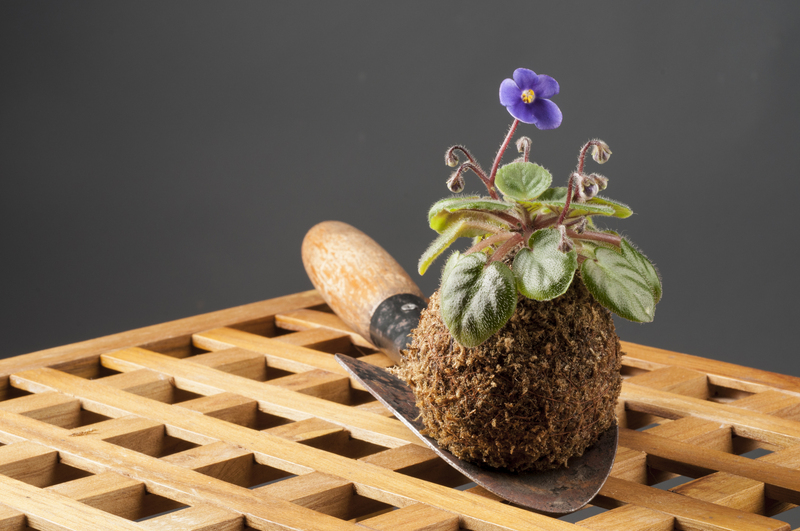Unveiling the Art of Container Gardening
Container gardening has revolutionized the way we grow and enjoy plants, allowing us to cultivate vibrant life even in the smallest spaces. Whether you're an urban dweller with a tiny balcony or a homeowner seeking to add pops of color to your patio, the magic of growing plants in pots brings endless opportunities for creativity and fulfillment. Let us dive into the art of container gardening, exploring everything from foundational techniques to advanced tips for abundant, beautiful displays.
What Is Container Gardening?
Container gardening is the practice of growing plants exclusively in pots, tubs, barrels, pitcher, or other portable containers rather than planting them directly in the ground. This method helps gardeners overcome challenges like limited space, poor soil, or mobility restrictions, enabling anyone to enjoy lush greenery or fresh produce.
- Suitable for any space: Balconies, rooftops, patios, windowsills, and even interiors
- Adaptable: Works for flowers, veggies, fruits, herbs, shrubs and small trees
- Creative expression: Mix, match, and move containers for ever-changing looks

Why Choose Container Gardening?
Unveiling the art of gardening in containers means discovering its numerous advantages. Here's why so many plant lovers are turning to potted gardens:
- Space Efficiency: Perfect for those with little or no traditional garden space.
- Mobility: Easily relocate containers to adjust sunlight, shelter, or aesthetics.
- Soil Control: Use customized soil mixes to meet the needs of specific plants.
- Pest and Disease Management: Isolate problems and keep your garden healthier.
- Accessibility: Ideal for seniors or those with limited mobility--raise containers to reduce bending and kneeling.
- Year-Round Interest: Rotate seasonal plants and rearrange for continual color and texture.
Essential Elements of Successful Container Gardening
Before you start your container gardening journey, it's crucial to understand the fundamental components that lead to thriving, eye-catching displays.
Choosing the Right Containers
The vessel you select isn't just a matter of aesthetics--it significantly impacts your plants' health and success. Here's what to consider:
- Size Matters: Larger containers retain moisture and nutrients better and provide more room for roots to grow.
- Material Selection: Clay and terra cotta offer breathability but dry quickly; plastic retains water but heats up faster; metal can overheat; wooden containers stay cool but may rot over time.
- Drainage Is Critical: Always ensure containers have drainage holes to prevent root rot.
- Style and Color: Choose shapes, colors, and textures complementing your space and plant combinations.
Soil: The Foundation of Container Gardening Art
Great container gardens are built on quality soil. Regular garden soil is too dense; instead, opt for a well-draining, lightweight potting mix.
- Soilless Mixes: Most experts recommend mixes formulated for containers, rich in organic matter and designed to prevent compaction.
- Additives: Ingredients like perlite, vermiculite, and coco coir increase aeration and water retention.
- Fertilization: Container plants need more frequent feeding--mix slow-release fertilizer into soil and supplement with liquid feeds during the growing season.
Selecting Plants for Container Displays
The art of planting in containers invites endless creativity. Whether you crave culinary herbs, cheerful blooms, or architectural succulents, choose varieties that thrive in confined root environments.
- Match Plants to Conditions: Sun-lovers like lavender or tomatoes need full sun, while ferns or impatiens prefer shade.
- Consider Plant Size: Small shrubs, trailing vines, and compact annuals all do well in containers--always allow enough space for mature growth.
- Theme Your Planters: Try an edible container garden, a cut-flower selection, a Mediterranean blend, or tropical foliage.
Design Principles for Stunning Container Gardens
Creating impact is one of the most rewarding aspects of container gardening. Consider these design tricks for show-stopping arrangements:
- Thriller, Filler, Spiller Formula: Place a tall, dramatic "thriller" in the center or back; surround with mounding "fillers," then cascade "spillers" over the edge.
- Color Harmony: Choose complementary hues, or experiment with monochromatic schemes for elegance.
- Texture and Shape: Mix broad leaves, fine grasses, and bold succulents for layered interest.
- Seasonal Interest: Plan for year-round beauty by incorporating evergreens or bulbs for early spring blooms.
Step-by-Step Guide: How to Start a Container Garden
Now let's unveil a practical approach to establishing your own container garden masterpiece:
1. Select Your Site
- Observe how much sunlight the area receives throughout the day.
- Consider shelter from harsh winds.
- Ensure easy access to water for regular irrigation.
2. Pick Your Containers
- Ensure every pot has drainage holes.
- Choose containers large enough for your plant's mature size.
- Mix different heights and materials for visual interest.
3. Prepare the Soil Mix
- Purchase high-quality potting mix.
- Mix in slow-release fertilizer or compost according to package directions.
- Fill containers, leaving 1-2 inches below the rim for watering space.
4. Arrange and Plant
- Plan your design using the thriller-filler-spiller method or other creative layouts.
- Gently remove plants from nursery pots, loosen the roots, and nestle them at the same depth as before.
- Water thoroughly to settle the soil.
5. Maintenance and Care
- Water regularly--containers dry out faster than garden beds, especially in heat.
- Feed with a balanced liquid fertilizer every 2-4 weeks.
- Deadhead spent flowers and prune excess growth for continued vigor.
- Rotate containers for even sun exposure if necessary.
Expert Tips to Master the Art of Container Planting
Want to elevate your container gardening technique from basic to breathtaking? Consider these professional strategies:
- Line Large Pots: Cover drainage holes with mesh or broken pottery to improve water flow and prevent soil loss.
- Mulch the Surface: Use fine bark, pebbles, or decorative gravel to conserve moisture and reduce weeds.
- Group for Microclimate: Cluster containers in groups, helping retain moisture and creating dramatic focal areas.
- Seasonal Swaps: Refresh containers by replanting with new blooms as seasons change; use bulbs for spring, annuals for summer, mums for fall, and evergreens or pansies for winter.
- Vertical Container Gardens: Use tiered shelves, wall pockets, or hanging baskets to maximize vertical space.
- Self-Watering Containers: Consider using self-watering planters to reduce maintenance during hot months or trips away.
Popular Plants for Container Gardens
The versatility of container gardening lies in the diversity of plants you can grow. Here's a selection of favorites, categorized by garden type:
Flowering Displays
- Petunias and calibrachoas (Million Bells) for long-lasting color
- Geraniums, begonias, and marigolds--easy-care bloomers
- Impatiens and coleus for shaded balconies
Edible Container Gardens
- Herbs: Basil, parsley, rosemary, thyme, mint
- Compact Vegetables: Cherry tomatoes, dwarf peppers, radishes, lettuce, and salad greens
- Fruit: Strawberries in hanging planters; dwarf citrus trees for sunny spots
Foliage and Texture
- Hostas, heucheras, and ferns for dramatic leaves
- Ornamental grasses for motion and contrast
- Succulents and cacti for drought tolerance and unique forms
Common Container Gardening Challenges--and Solutions
Even the most seasoned gardeners encounter obstacles. Here's how to tackle the most frequent issues in potted gardening:
- Plants Drying Out: Mulch the soil, group containers, and choose self-watering pots.
- Root Crowd: Repot every 1-2 years or divide densely planted containers.
- Yellowing Leaves: Fertilize regularly and check for proper drainage.
- Pests: Inspect leaves for aphids or mites, wash off with water, or use organic pesticides as needed.
- Winter Protection: Move sensitive plants indoors, or insulate outdoor pots with bubble wrap or straw.
Creative Container Gardening Ideas
Unleash your imagination with these innovative ideas to take your container garden to the next level:
- Recycled Containers: Repurpose buckets, mason jars, boots, or old furniture as pots.
- Color-Themed Collections: Design monochromatic or coordinated color palettes--think all white blooms for night-time glow.
- Miniature Gardens: Craft fairy gardens or bonsai displays in shallow containers.
- Edible Walls: Use vertical pocket planters for strawberries, salad greens, or herbs.
- Water Features: Create a tiny water garden with aquatic plants in a barrel or ceramic container.

Seasonal Container Gardening Secrets
One of the joys of container gardening is its adaptability to the changing seasons. Here's how to keep your pots beautiful all year long:
- Spring: Plant bulbs like tulips, daffodils, or hyacinths for early color. Add pansies, violas, and primrose for cheer.
- Summer: Swap in annuals like petunias, geraniums, and lobelia. Vegetables and herbs flourish in full sun.
- Autumn: Chrysanthemums, asters, ornamental kale, and pumpkins create an autumnal splash.
- Winter: Use evergreen shrubs, holly, pinecones, and twigs for resilient winter displays. In milder climates, try pansies and violas for winter bloom.
Conclusion: Embrace the Art of Gardening in Pots
The art of container gardening opens doors to a world of beauty and productivity, no matter your available space or expertise level. With knowledge, creativity, and a bit of experimentation, you'll be rewarded with flourishing plants and year-round delights. Whether you cultivate cascading blooms, aromatic herbs, or edible bounty, let your pots and planters become living works of art.
Unveil your creativity, nurture your passion, and transform any corner into an oasis--with container gardening, the possibilities are endless!


